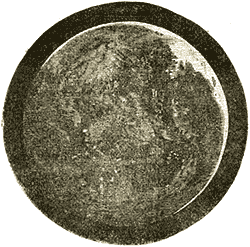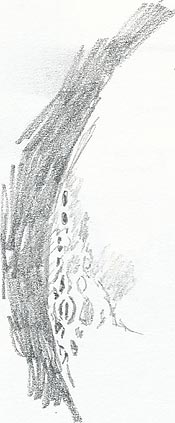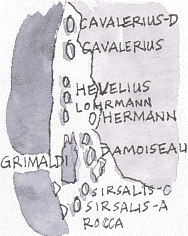 The Waters of the Moon
The Waters of the Moon The Waters of the Moon
The Waters of the MoonWild West Yorkshire, Thursday 21 October 2010
previous | this month | next
THIS EDWARDIAN description of the experience of the reduced gravity of the Moon conjures up the amateur backyard approach to space exploration imagined in H G Wells' The First Men in the Moon:
“Not only would a bicycle be driven along with unparalleled ease and rapidity if lunar roads were smooth, but even the disagreeable process of taking a header over the handles would lose its terrors, for the lunar bicyclist would fall gently and softly to his mother earth.”
Sir Robert S Ball, In the High Heavens, 1908
Cassell's Science Popularly Explained, from half a century earlier, in the mid-Victorian period, describes the Moon 'under the telescope' (as illustrated in the engraving, right) as:
“studded with rough and ragged mountains, whose tops resemble the craters of volcanoes, or the sharp, conical peaks of the terrestrial volcanoes Cotopaxi, Etna, Vesuvius, &c.
 The author, David A Wells, suggests that this rugged moonscape is due to the absence of water which “upon the earth, has so modified its surface, that its original igneous character is concealed in part beneath the sedimentary, aqueous, or stratified rock.”
The author, David A Wells, suggests that this rugged moonscape is due to the absence of water which “upon the earth, has so modified its surface, that its original igneous character is concealed in part beneath the sedimentary, aqueous, or stratified rock.”
I wish he could have lived to see the Apollo astronauts land in the Sea of Tranquility. He was right to think that lunar rock is of igneous origin but it's now apparent that almost every crater we see on the Moon is the result of a meteorite impact, although there are a handful of cones that might prove on closer examination to be lunar stratovolcanoes.
On the title page of Science Popularly Explained, Wells (that's D A, not H G) quotes the President of the British Association for the Promotion of Science, speaking in 1855:
“If there is one fact of which science reminds us more perpetually than another, it is that we have faculties impelling us to ask questions which we have no powers enabling us to answer.”
 I feel lucky that I've been part of the generation who have at last had the powers to answer some of our questions about the moons, planets, asteroids and comets of our solar system. We're still learning; writing in 1984 in The New Atlas of the Universe, Patrick Moore, an observer whose lunar maps were used by NASA when planning the moonshot, stated emphatically: “It has also been established that the lunar materials contain no trace of H2O in any form. The Moon has always been waterless and therefore lifeless.”
I feel lucky that I've been part of the generation who have at last had the powers to answer some of our questions about the moons, planets, asteroids and comets of our solar system. We're still learning; writing in 1984 in The New Atlas of the Universe, Patrick Moore, an observer whose lunar maps were used by NASA when planning the moonshot, stated emphatically: “It has also been established that the lunar materials contain no trace of H2O in any form. The Moon has always been waterless and therefore lifeless.”
By the drastic experiment, a year ago on October 9, of smashing a redundant space rocket into the Cabius crater near the Moon's south pole and analysing the debris ejected on impact, we now know, as announced this week, that the lunar surface holds vast amounts of water; 50 litres per ton or 5.6%.
This evening I drew craters on the far west face of moon including Grimaldi, at 148 miles across one of the largest wall-surrounded plains on the Moon and possibly the darkest area on its surface.
Richard Bell, illustrator
previous | this month | Wild West Yorkshire home page | next